Sand Land review - a fitting tribute to a wonderful author
Just deserts.
Before I was even old enough to qualify as a teenager, I was obsessed with the works of Akira Toriyama. Dragon Ball, Dragon Quest, Dr Slump, Chrono Trigger - everything Toriyama-related I could get my hands on blew my 13-year-old mind.
It didn't take me long to get around to Sand Land, Toriyama's 14-chapter-long manga released all the way back in 2000. I was young and naive, fresh off the back of completing Chrono Trigger for the first time, but something about a video game adaptation of Sand Land immediately wormed its way inside my brain. Toriyama and video games had already proven to be a perfect combo, so I thought the scrappy, video game-obsessed protagonist Beelzebub and the barren, gang-filled wastelands of Sand Land were an obvious lay-up.
Then I grew older, and naturally I became more cynical. Sand Land's story was barely long enough for a film adaptation, let alone a video game, and a couple of fight scenes and a few tank battles couldn't provide enough inspiration for an in-depth combat system. Then, on the 1st of March, Akira Toriyama passed - long after his work on Sand Land was complete. My apathy transformed into dread. The odds seemed stacked against developers ILCA. Surely this would be another Mobile Suit Gundam: Crossfire or Astro Boy: The Video Game, one more uninspired, frigid anime game for the bargain bin. I don't think I've ever been happier to have been proven wrong.
Sand Land is a bit of an odd game to categorise. It's an action RPG, on the surface. You play as Beelzebub, the Prince of Demons, as he attempts to locate a water source for the barren wasteland that is Sand Land, alongside his old friend Thief and his new human compatriot Rao. When you're playing as Beelzebub, Sand Land feels like a Musou game - a simple beat-'em-up where you hit light attack until you decide to hit heavy attack to end your combo. However, you're probably only going to be directly using Beelzebub for around 10 to 15 percent of your playthrough. The real meat of Sand Land is in its vehicular combat, which makes it more akin to games like Rage or Twisted Metal. There are a few platforming sections, some forced stealth missions and a whole slew of NPCs you have to talk to for side quests, but make no mistake - you'll be spending most of your time blowing stuff up in a tank or punching stuff inside a big robot.
Speaking of tanks, my scepticism took the driver's seat for the first few hours of my playthrough. Controlling Beelzebub in combat felt a little bland, tank combat felt too rudimentary to remain engaging for an entire playthrough, and I was already more than halfway through Sand Land's original story in the manga with only five hours of playtime on the clock.
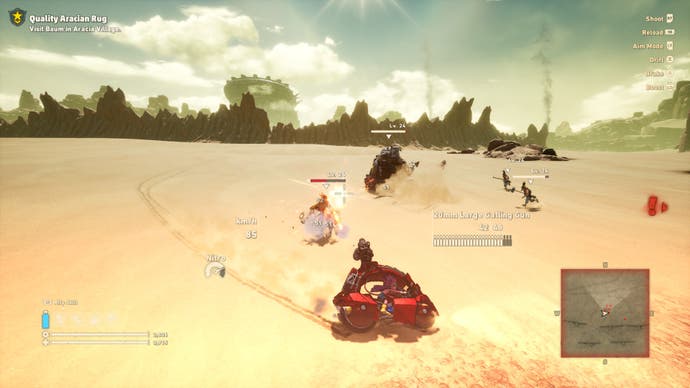
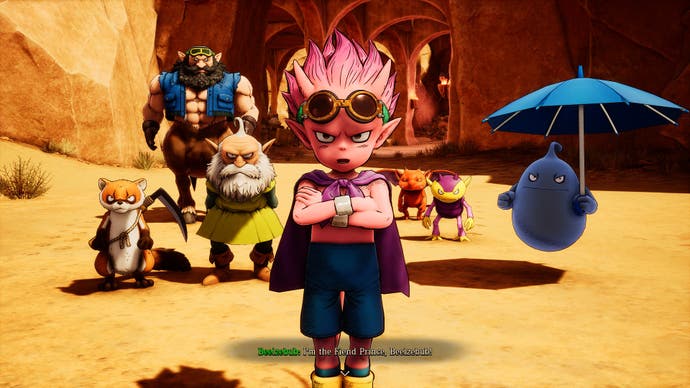
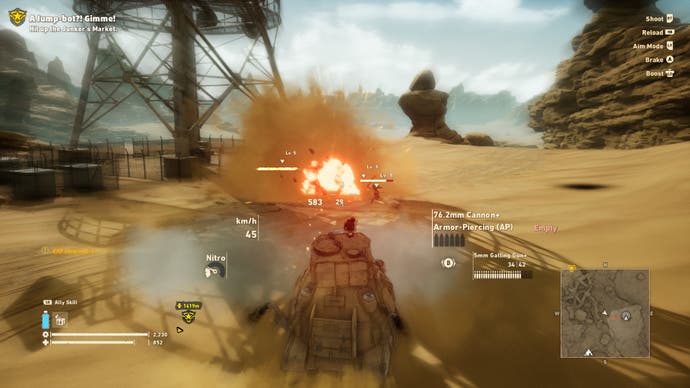
After another five hours, Sand Land finally started to pique my interest. Upgrades to Beelzebub's skill tree and newly unlocked abilities made combat feel a little weightier. Vehicular combat started to take the centre stage, with a well-paced series of upgrades and new vehicle types helping to keep me engaged. The story began to take some creative liberties with the source material, but not to its detriment, allowing a longer and slightly altered narrative to give the developers more space to work in the types of story missions that lend themselves better to a video game - no doubt a result of Toriyama's direct involvement in writing the game's adaptation of the story.
The main focus of Sand Land's gameplay, the vehicle building and combat, gives the game a very distinct feel. Other games, for instance something like World of Tanks, are definitely working on a broader scale when it comes to vehicle customisation, but Sand Land is unparalleled when compared to other vehicular combat games that also serve as RPGs. You can keep five mechs in your capsule that you can immediately jump into, and I ended up getting so attached to several of my mechs that choosing which five to have equipped always proved difficult. I became very attached to my motorbike, mostly because of how fast and responsive it was to control due to my upgrades, but letting go of any of my custom-built vehicles always proved difficult. Much like Beelzebub, as the story progressed and a new mech became available I was always immediately excited to build and customise it - a testament to how different each vehicle feels to pilot.
As for the writing, I think the new storyline that comes after the first half of the game is brilliant. I don't want to spoil much, because for fans of Sand Land this will essentially serve as a sequel to the original manga, but the second half of the main quest is arguably even better than the first. This is where the most interesting boss fights take place and where you unlock the second half of the map too, so I would suggest sticking things out if you start to get bored towards the end of the first half of the game. The opportunity to write a follow-up to the main story clearly came with the added benefit of allowing developer ILCA a lot more freedom to design missions that aren't constricted by the original manga's plot, and it really shows. Whilst I am extremely happy that they did the original manga justice, the second half of the main quest is definitely stronger, gameplay-wise, and Toriyama's writing in the new storyline is just as good in 2024 as it was back in 2000.
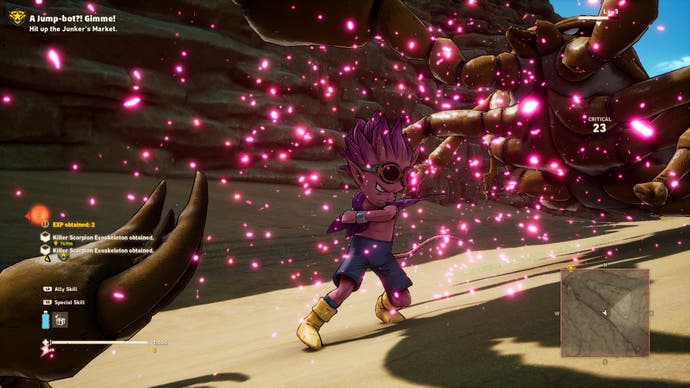

It isn't all positive, however. Firstly, there are quite a few forced stealth missions in the main story (I counted five) and a couple of side missions. The stealth gameplay is barebones, and it's neither challenging nor fun. Thankfully these segments are easy and quick to complete, but they ultimately just felt unnecessary. Secondly, a few of the main missions ended up feeling very similar to one another. The first time I got to explore one of the wreckages of an old superweapon, it felt new and exciting; a fresh environment to explore with different enemies to fight. The fifth time it started to feel boring, especially when the interiors all ended up looking very similar to one another. Finally, and this might seem like a bit of a nitpick, but your party repeats the same dialogue lines when you're out of combat way too often. I think I must have heard Thief and Rao have the same discussion about the follies of humankind up to 40 times before I finished the game.
Performance-wise, Sand Land ran perfectly on PC. Halfway through my playthrough, I remembered playing the demo a few weeks prior and how terrible the performance had been. Constant stuttering and odd texture issues in the demo made me worry that the full game would be a classic case of a terrible PC port. However, I played the full release at 120 FPS with all of the settings at their highest and Sand Land felt consistently smooth throughout. I went back to play the demo briefly just to make sure I wasn't imagining things and it definitely still had the same stuttering issues it had before, so I can happily report that they seemed to have ironed out the issues for the full release.
30 hours into Sand Land, I had a strange realisation. Sand Land ultimately isn't a story about its lead character, Beelzebub, but instead a story about his chance meeting with the old man Rao. Rao is at odds with himself, an elderly man with a guilty conscience. He's distrustful of people and demons alike, but he constantly tries his best to keep an open mind and to not assume the worst of others. The childlike Beelzebub is simply along for the ride, but his innocence and his inability to lie leads Rao to continually place his trust in him.

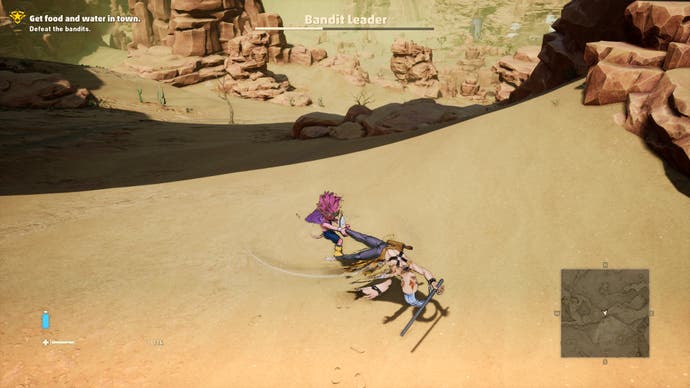
As a teenager, I naturally identified with the overtly mischievous Beelzebub. But through experiencing Sand Land's story for a second time at a much older age, I realised I'd come to have much more in common with Rao. Just as the wizened old man in Sand Land's story had finally allowed the wide-eyed Beelzebub to literally take the wheel, I realised I had done the same throughout the course of my playthrough. I assumed the worst of Sand Land during my first few hours with it, but its goofy, simple fun slowly chipped away at me the longer I played. It is simultaneously a thrilling adaptation and an enjoyable experience, an unusual example of an anime game that makes smart changes to its source material in favour of its gameplay.
The team at ILCA clearly love Sand Land, and the only proof you need of this fact is the game itself, but it's also clear that Bandai Namco gave the developers a decent amount of time to see their vision through. The maps are large and expansive, and the sheer amount of side quests and side content do a great job of fleshing out the world in a way the manga never did. Once I was done with Sand Land, I'd managed to pour roughly 50 hours into it and it rarely felt like the game was padding itself out. I still actually have a few pieces of side activities left to do, so I'm not even entirely sure how long Sand Land will end up taking me to fully complete - but I am excited to find out.
Sand Land feels like a passion project, the rare example of an anime game that actually elevates and improves the story it was based on. Sand Land doesn't get everything right, but it's more than I ever hoped for or expected. Most importantly however, I think ILCA should be extremely proud of doing Akira Toriyama's legacy justice. Sand Land is the game that his fans deserve, and a wonderful final reminder of the incredible impact that one man has had on the gaming industry.
A copy of Sand Land was provided for review by Bandai Namco.


.jpg?width=291&height=164&fit=crop&quality=80&format=jpg&auto=webp)